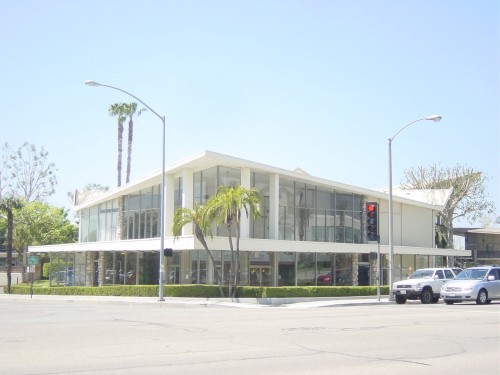An old gas station was recently remodeled with a small addition along Harbor Blvd. And I might say it’s one of the most creative adaptive reuse projects we’ve seen in Fullerton for many years, and it’s very pleasant to look at. It has no fake columns, no fake second floors, no tile roof, it’s very simple and honest. Frank Webb Architects is the owner, designer and occupant of this very cool building located just north of Berkley on Harbor. This project had no redevelopment dollars and no subsidy. Friends for Fullerton’s Future welcomes Frank Webb, his partners and his employees to Fullerton.
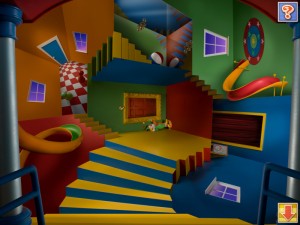
A while back we made reference in a post to a type of architecture called “HAVE FUN DAMMIT Post Modernism.” See comment #13
Several of you Dedicated Friends had questions about our nomenclature, and rather than inch out any farther onto the thin ice of architectural taxonomy, we have decided to turn the task over to an expert. And so, once again, we rely upon the kind offices of Dr. Ralph E. Haldemann, Professor of Art History (Emeritus) at Otterbein College, Ohio, our Adjunct Arts and Architecture Editor.

Writes Dr. Haldemann:
You have astutely identified a stylistic trend in government subsidized commercial architecture. The outward trappings are meant to induce retail sales through the medium of bright colors, unexpected or weird angles, ostensibly playful and upbeat features and signage; all in an effort to promote a festive, even amusement park-like atmosphere. This mood of jollity is meant to help pry loose disposable income from the local proletarians and thus support a city’s sales tax base. Some of the elements are congruent with the coeval deconstructivism of Post-modern architecture, although any disorientation produced by the former is generally intended to foster a suspension in fiscal responsibility.
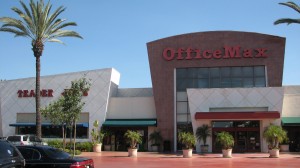

Since the have-fun-at-all-cost approach necessarily requires a “hard sell” many have recognized a cruel irony in the attempt to force feed fun, especially in economically distressed areas.
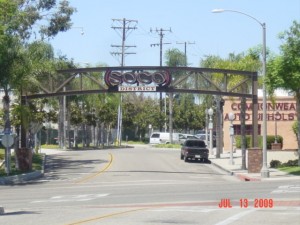
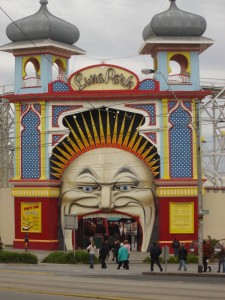
Since many of these structures and complexes have predictably refused to age with any sort of dignity, critics find solace with the prospect that these buildings will soon be “redeveloped” by the same suburban renewal urges that created them in the first place.
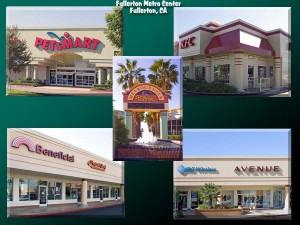
Finally, I note that many of the themes of this style have sloshed over in to other non-commercial municipal enterprises with fairly appalling consequences.
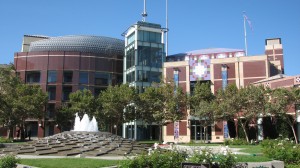
Thanks, Dr. Haldemann, for another lucid and enlightening exposition. Your FFFF check is in the mail, but please don’t cash it ’til the end of the month.

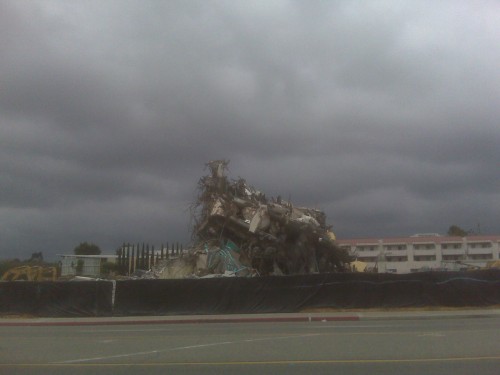
Why did the City Council vote to extinguish several office buildings, all which contributed to Fullerton’s business zone and stock of professional offices, as well as our historic built environment? Besides a crappy deceitful plan called Jefferson Commons for more student housing on a private college campus, the city lost a huge asset, one that helped create the historic character of East Fullerton for the past 50 years. Shame on them!
Correction to this post: I have been informed that the project cannot legally be exclusively for students, despite the council repeatedly calling it “student housing”. It is a private development, and they cannot discriminate against non-students who want to rent there.
New Fullerton resident Marco Torres is a young self taught photographer whose work can be described as the fifth and final stage of sleep where the mind produces its most lucid hallucinations, confusing a dream with life, the ambiguity of tragedy or triumph engages the audience through out the entirety of each piece; a keen eye for bizarre locations both extraordinary and mundane is what sets this young up and coming artist apart from the rest. Click here to see more of Marco’s work.
UPDATE: In our carelessness we omitted citation for the image of “Donald’s Serva-teria. We got it here, and apologize for the oversight.
– Joe Sipowicz
In our previous post here we identified the buildings at the Hope University campus as “Exaggerated Modern.” Being unusually perspicacious, we have anticipated that some of our Friends will want an explanation of what this architectural term means, and that some even may suspect that we just make this stuff up for fun.
And so we have called upon the good offices of Dr. Ralph E. Haldemann, Art History Professor (Emeritus) at Otterbein College, Ohio – our adjunct Arts and Architecture editor – to expound upon the term he so helpfully provided for our prior post. We reproduce his scholarly explanation below:

The term “exaggerated modern” simply means a style that uses the materials and structural emphasis of Modern architecture, with exaggerated features: soaring, cantilevered roofs, expansive and often canted storefronts, and the deployment of exposed structural elements like precast concrete, steel trusses, etc., to emphasize engineering virtuosity. The style is resolutely exuberant, commercial, and auto-oriented. The style dominated American roadside architecture between 1955 and 1965, and even made inroads into high-style architectural efforts such as the buildings at Hope U.

Exaggerated Modern ought not to be confused with the term “googie” – an applique design phenomenon that in some ways parallels Exaggerated Modern. Googie themes tend to be kitschy renditions of popular 1950s scientific imagery – atomic, astronomic, and zoological (amoeboid shapes); or fun arrangements of geometric shapes, patterns, and colors, etc. These energetic and playful themes will very likely be housed in structures exhibiting Exaggerated Modern attributes, or on attached or adjacent signage; but the two notions should not be conflated.

Professor Chester H. Liebs has aptly described the outlines and history of Exaggerated Modern in his magisterial book From Main Street to Miracle Mile, Little Brown & Co., Boston, 1985. cf. pages 59-64. click here to see
Thanks, Dr. Haldemann. The check is in the mail!

We have it on good authority that when Hope University hightails it from Fullerton to points south, the Exaggerated Modern buildings on their erstwhile campus may be in danger. How come? Because the very entity that built them in the 1960s – CSUF – is said to be eager to reacquire the property. Based on their recent architectural efforts, a massively overbuilt campus, plus the need to house more students like sardines, the future isn’t too hopeful for the buildings on the Hope U. campus.

The complex of buildings that originally served CSUF as graduate student housing, bookstore, and cinema with their glass walls and soaring roofs have been recognized by many for their architectural value – but never by a governmental entity – and in government land planning thats all that really counts. They have not been recognized by the City, the County, or the State as an historical resource and at present have nothing standing between them and a possible wrecking ball except Fullerton Friends willing to work to preserve them.
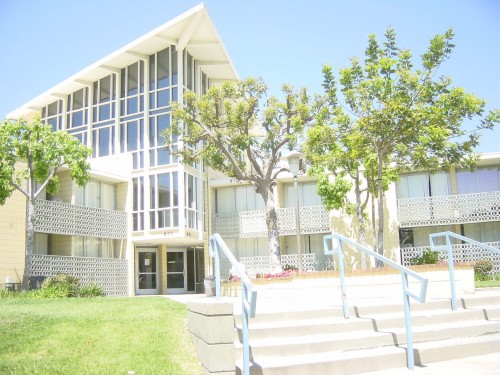
If we set aside the irony of the CSUF buying back property they once owned, and focus on the aesthetic importance and the sound construction used and the opportunity for creative re-use, we can only conclude that these buildings are worth saving!
Please call State Assemblyman Mike Duvall (714/672-4734) immediately to let him know what you think; e-mail Fullerton City Council members (Council@ci.fullerton.ca.us) to let them know that this complex of buildings deserves to be an historic district. Don’t forget to call Chris Norby, County Supervisor at 714/834-3440 to ask for his support.
If you are a member of the heritage group be sure to tell your board that you want these gems of modern architecture preserved – unlike the buildings currently being demolished on Chapman Avenue to make way for the “Jefferson Commons” monstrosity.
WORKING TOGETHER WE CAN SAVE THIS RESOURCE FOR THE PEOPLE OF FULLERTON, ORANGE COUNTY, AND CALIFORNIA!
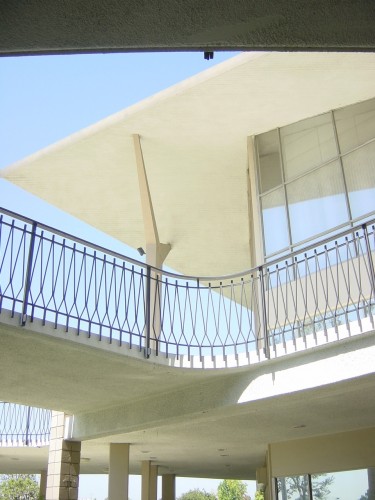
P.S. We have asked our Arts & Architecture Department to develop an educational post to define just what “Exaggerated Modern” is. We hope (no university) you will stay tuned.
